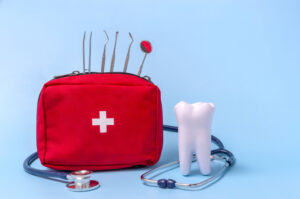Dental emergencies can come unexpectedly, causing pain, discomfort, and anxiety. Knowing how to recognize and respond to these situations can make a significant difference in preserving your oral health and preventing further complications. This guide will help you identify common dental emergencies and provide immediate solutions to manage them effectively until you can see a dentist.
1. Knocked-Out Tooth (Avulsed Tooth)
What Happens?
A knocked-out tooth is one of the most severe dental emergencies. This often occurs due to accidents, sports injuries, or falls.
Immediate Solutions
- Handle with Care: Pick up the tooth by the crown (the part you see in the mouth), avoiding the root to prevent damage to the delicate tissues.
- Rinse Gently: If the tooth is dirty, rinse it gently with water. Do not scrub or remove any attached tissue fragments.
- Reinsert if Possible: Try to place the tooth back into the socket immediately. Hold it in place with gentle pressure.
- Keep Moist: If reinsertion isn’t possible, place the tooth in a container with milk or a saline solution. Avoid using tap water as it can damage the tooth.
- Seek Immediate Care: Visit a dentist or an emergency dental service within 30 minutes for the best chance of saving the tooth.
Fact: According to the American Association of Endodontists, the success rate of reimplantation is highest within the first 30 minutes.
2. Cracked or Broken Tooth
What Happens?
A cracked or broken tooth can result from biting down on hard foods, trauma, or accidents. This can expose the inner layers of the tooth, leading to pain and increased risk of infection.
Immediate Solutions
- Rinse Your Mouth: Clean the area with warm water to remove any debris.
- Apply a Cold Compress: Place a cold pack on your face near the affected area to reduce swelling and numb the pain.
- Protect the Area: Use dental wax to cover sharp edges if the break is causing irritation to your tongue or cheek.
- Avoid Certain Foods: Stick to soft foods and avoid chewing on the affected side to prevent further damage.
- Contact a Dentist: Schedule an appointment as soon as possible to repair the tooth and prevent complications.
3. Severe Toothache with Swelling
What Happens?
A severe toothache accompanied by swelling may indicate an abscess or infection. This condition can spread to other parts of the body if left untreated.
Immediate Solutions
- Rinse with Warm Salt Water: This can help reduce bacteria and alleviate discomfort.
- Apply a Cold Compress: Place it on your cheek to minimize swelling.
- Take Over-the-Counter Pain Relievers: Ibuprofen or acetaminophen can help manage the pain.
- Elevate Your Head: Keeping your head elevated can reduce blood flow to the affected area, minimizing swelling.
- Seek Emergency Dental Care: Contact an emergency dentistry service immediately to address the underlying infection.
Fact: Dental abscesses can lead to serious health issues like cellulitis or sepsis if not treated promptly.
4. Loose Tooth in a Child
What Happens?
Children may experience loose teeth due to natural shedding or trauma. A loose tooth caused by injury requires immediate attention to prevent further complications.
Immediate Solutions
- Handle Gently: Encourage the child to wiggle the tooth with clean hands, but avoid forcing it.
- Rinse the Mouth: Use warm salt water to clean the area around the loose tooth.
- Apply a Cold Compress: This can help reduce swelling and numb the area.
- Avoid Hard Foods: Stick to soft foods to prevent additional stress on the loose tooth.
- Visit a Dentist: Schedule an appointment to ensure the tooth is managed correctly and to prevent any permanent teeth from being affected.
5. Objects Stuck Between Teeth
What Happens?
Objects like food particles, dental instruments, or small items can become lodged between teeth, causing discomfort and potential gum irritation.
Immediate Solutions
- Try to Remove It Yourself: Use dental floss or a toothpick carefully to dislodge the object.
- Use a Water Flosser: A water flosser can help flush out the trapped object without causing injury.
- Rinse Thoroughly: Use warm water to rinse your mouth and dislodge any remaining debris.
- Avoid Sharp Objects: Do not use metal tools that can damage your gums or teeth.
- Contact a Dentist if Needed: If you can’t remove the object or experience pain, seek professional help.
6. Dental Abscess
What Happens?
A dental abscess is a pus-filled infection that occurs at the root of a tooth or between the gum and a tooth. It can cause severe pain, swelling, and fever.
Immediate Solutions
- Rinse Your Mouth: Use warm salt water to cleanse the area.
- Apply a Cold Compress: This helps reduce swelling and numb the pain.
- Take Pain Relievers: Over-the-counter medications can help manage the pain and reduce inflammation.
- Avoid the Affected Area: Refrain from chewing on the side with the abscess to prevent further irritation.
- Seek Urgent Dental Care: An abscess requires professional treatment to drain the infection and address the underlying cause.
When to Seek Immediate Dental Care
Not all dental issues require emergency attention, but knowing when to seek help can prevent minor problems from becoming major ones. Consider visiting a dentist immediately if you experience:
- Severe Pain: Persistent or intense tooth pain.
- Visible Injuries: Broken, chipped, or knocked-out teeth.
- Swelling: Swelling in your gums, face, or neck.
- Difficulty Breathing or Swallowing: Any issues with breathing or swallowing require urgent care.
- Persistent Bleeding: Uncontrolled bleeding from gums or other oral tissues.
- Signs of Infection: Fever, chills, or a bad taste in the mouth indicating an abscess or infection.
Prevention Tips to Avoid Dental Emergencies
While not all dental emergencies can be prevented, adopting good oral hygiene and safety practices can significantly reduce the risk:
- Maintain Good Oral Hygiene: Regular brushing, flossing, and using mouthwash help prevent tooth decay and gum disease.
- Wear Mouthguards During Sports: Protect your teeth from injuries by wearing a mouthguard during contact sports or high-impact activities.
- Avoid Hard Foods and Objects: Chewing on hard foods like ice or popcorn kernels and avoiding biting on pens or other objects can prevent chipped or broken teeth.
- Regular Dental Checkups: Routine visits allow your dentist to identify and address potential issues before they escalate into emergencies.
- Address Dental Issues Promptly: If you notice any signs of dental problems, such as tooth sensitivity, bleeding gums, or minor pain, seek professional care immediately to prevent complications.
Conclusion
Understanding what constitutes a dental emergency and knowing how to respond can preserve your oral health and prevent severe complications. From managing a knocked-out tooth to addressing severe toothaches, being prepared ensures you take the right steps when it matters most. Maintaining good Oral Hygiene, wearing protective gear during sports, and attending regular dental checkups are proactive measures that can minimize the risk of dental emergencies. However, when an emergency does arise, staying calm and knowing the


